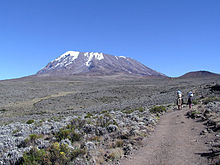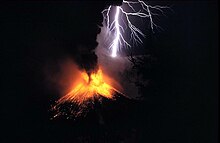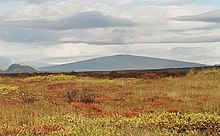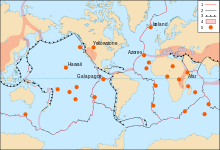volcano

A volcano is a geological structure that is created when magma ( molten rock ) rises to the surface of a planet (e.g. Earth). All of the side effects associated with the rise and discharge of the glowing molten rock are referred to as volcanism . When a volcanic eruption occurs , not only embers, but also solid or gaseous substances are released.
In the case of the earth melt rocks from 100 km depth, at temperatures 1000-1300 ° C . Rocks melt into viscous magma , which gathers in large, drop-shaped magma herds at a depth of 2 to 50 km. If the pressure becomes too great, the magma rises over crevices and crevices in the lithosphere . Magma that comes to the surface of the earth is known as lava .
Most volcanoes are roughly shaped like a cone , the slope of which depends on the viscosity of the lava. The shape can, however, also be arched irregularly or in the shape of a dome .
etymology
The term "volcano" is derived from the Italian island of Vulcano . This is one of the Aeolian Islands in the Tyrrhenian Sea . In Roman mythology , this island was considered the forge of Vulcanus , the Roman god of fire .
Volcano types and names
Volcanoes can be divided according to their external shape, the nature of their magma supply system, the location of their occurrence, the nature of their activity and their condition.
- Subdivision according to the external shape:
- Stratovolcanoes (also called stratovolcanoes)
- Shield volcanoes
- Cinder and ash cones
- Lava dome
- Maar
- Caldera
- Tabular volcano
- Ceiling or plateau volcano (compare also Trapp and flood basalt )
- Subdivision according to the type of magma supply system:
- Subdivision according to the place of their occurrence:
- subaeric volcanoes (volcanoes on land or over water)
- submarine volcanoes , seamount , guyot (volcanoes in the sea underwater)
- subglacial volcanoes (volcanoes under a glacier)
- extraterrestrial volcanoes (volcanoes on other celestial bodies)
- Subdivision according to the type of activity:
- effusive activity (calm flow of lava)
- explosive or ejective activity
- mixed effusive and explosive activity
- Volcanoes with particularly violent explosive activity are called super volcanoes
- Finally, volcanoes can also be classified according to their condition or the frequency of their activity
- active volcanoes (active volcanism)
- inactive or dormant volcanoes (no active volcanism, but conditions for renewed activity are given)
- extinct volcanoes (no more activity possible due to missing magma supply)
However, many volcanoes do not follow a “pure” eruption pattern, but rather show varying behavior either during an eruption or during the millions of years of their activity. One example is Mount Etna in Sicily .
A paroxysm (Greek παρα para “next to”, οξυς oxys “sharp”) is a sequence of increasing eruptions of a volcano.
The mountain formed by volcanic activity is called a volcanic cone or volcanic dome , depending on its shape , and the opening from which lava rises from the depths is called a volcanic vent . The more or less wide opening at the top of a volcano is the volcanic crater . If a chimney collapses over a shallow magma chamber and a large collapse crater forms, this is known as a caldera .
Igneous types
In addition to the gas and water content, the composition of its magma, especially the content of silicon dioxide (SiO 2 ), has a decisive influence on the formation of a volcano . The composition of the magma determines the nature of the volcanic activity. The more SiO 2 the magma contains, the more explosive the associated volcanism. Four main types can be distinguished:
- Felsic magma contains more than 63% SiO 2
- Intermediate magma contains between 52 and 63% SiO 2
- Mafic magma contains between 45 and 52% SiO 2
- Ultramafic magma contains less than 45% SiO 2
Characteristic rocks arise from the four types of magma:
These four types can be roughly assigned to certain geodynamic environments:
- Melting the continental crust
- Subduction zones
- Mid- ocean ridge , hotspot volcanism, rift volcanism
- Volcanism no longer occurring today in early phases of geogenesis
Lava types
Volcanoes can also be classified otherwise by describing them by the color of the emerging lava.
The color of the emerging lava depends on the temperature, but can also be traced back to the chemical composition of the molten rock. The resulting shape of the volcano as well as the eruption behavior are decisively determined by the composition of the rock melt:
- Red volcanoes are so named because of the red or orange-yellow glowing, hot lava, they form shield volcanoes .
- Gray volcanoes have a comparatively low lava temperature and form stratovolcanoes .
Events mainly triggered by volcanoes
When volcanoes erupt, further processes can be triggered by the mixing of volcanic material with other substances such as water or air and by the abrupt escape of lava. These include:
- Lahar (streams of mud and debris)
- Pyroclastic currents (glowing avalanche)
- Base surge (low-particle density flow)
- Ember cloud
- Glacier run
- Tsunami : If large amounts of magma or even parts of the mountain flanks fall into the sea during a volcanic eruption, tsunamis can be triggered. These often reach greater heights than the tsunamis generated by seaquakes.
Also, earthquakes occur before or after the eruption of a volcano as they can influence each other.
Other ascending materials that are responsible for the so-called mud volcanoes (better known as mud diapirs) are not part of volcanism .
Distribution of volcanoes
According to volcano type
There are around 1500 active people worldwide today, i. H. Volcanoes erupted on the earth's surface in the last 10,000 years, but the number of submarine volcanoes is not yet known , of which there are probably many more.
Of these, 719 are classified as stratovolcanoes , 176 as shield volcanoes , 66 as complex volcanoes , 86 as caldera , 147 as individual cinder cones , 27 as crevice volcanoes or crater series , 19 as maar , 137 as submarine volcanoes and 100 as volcanic fields (with several hundred individual volcanoes in some cases) .
According to geography
The geographical distribution can be understood with the help of the knowledge of plate tectonics :
- With a few exceptions, volcanoes in the spreading zones lie on the seabed, where the tectonic plates drift apart. The magma that occurs there is basaltic and is depleted of elements that are difficult to integrate into crystal lattices ( incompatible elements ) . These mainly include red volcanoes or shield volcanoes .
- Volcanoes over subduction zones are the most visible volcanoes. They occur in plate collisions in which at least one oceanic lithospheric plate is involved. Here the oceanic crust is transported (subducted) into the mantle, provided that its age-dependent density has reached a sufficiently high value. The submerged oceanic crust is partially melted in the depths, because the high water content in certain minerals leads to a lowering of the solidus (temperature of the beginning of melting). The resulting magma rises, as it has a lower density than the surrounding rock, and feeds the volcanism on the surface. The resulting volcanoes are known as stratovolcanoes or stratovolcanoes due to their layered structure.
- Volcanoes over “ hotspots ” are rare, as there are currently only about 40 clearly defined “hotspots” worldwide . A “hotspot” is a melting area in the earth's mantle below the lithosphere that can be regarded as almost stationary over geological time periods . The lithospheric plates move over a “hotspot” over long periods of time due to plate tectonic mechanisms. New volcanoes form one behind the other like a string of pearls, as if they were welding their way through the crust. The best- known example are the Hawaiian Islands: the largest island of Hawaii , which is the youngest volcanic island above the "hotspot", is only 400,000 years old, while the oldest of the six volcanic islands of Kauaʻi in the northwest was formed around 5.1 million years ago. Examples of this rare type of volcanism in Europe can be found in the East and West Eifel ( Vulkaneifel ), the Siebengebirge and the Auvergne . There is also such a hotspot under Iceland .
In the solar system
Volcanism is a normal phenomenon for terrestrial celestial bodies. Traces of extinct volcanism can be found on many worlds of the solar system, such as on the Earth's moon or Mars . The most volcanically active world in the solar system is Jupiter's moon Io . On Saturn's moon Enceladus as well as the Neptune moon Triton was Kryovulkanismus observed.
On the other hand, on Venus, which is very Earth-like in terms of mass, size and internal structure, there are only few indications of currently active volcanism and no signs of plate tectonics.
Prediction of volcanic eruptions

People who live in the vicinity of a volcano are particularly interested in whether a volcano is finally extinct or can perhaps become active again. In any case, a volcanic eruption has far-reaching consequences, because the infrastructure and economy of the affected region are influenced in a lasting way beyond personal fate . Therefore, the primary research goal is to be able to predict volcanic eruptions as precisely as possible. Incorrect prognoses would be devastating from the point of view of costs alone ( evacuation of thousands of people, shutdown of the entire economic life and much more).
Despite certain similarities, no two volcanoes are the same in terms of their eruption behavior. Accordingly, observations about periods of rest or seismic activity from one volcano can hardly be transferred to another.
When monitoring volcanoes, five monitoring methods are generally available, which are used in different combinations depending on the volcanic characteristics: recording seismic activity, geodetic monitoring of the topography, measurement of gravimetric and magnetometric changes, recording of near-surface temperature increases and chemical Analysis of rising volcanic gases.
Record of seismic activity, volcanic tremor
An eruption process is initially initiated by the rise of the magma. When the magma rises to the surface of the earth on pre-drawn or new fault lines, crevices or cracks, characteristic seismic signals arise due to tensions in the surrounding rock and degassing processes of the magma. Rock breaks and cracks begin to vibrate. The destruction of rock triggers earthquakes with high frequency of the movement of cracks on the other hand leads to low-frequency quakes, the so-called volcanic tremor .
In order to determine the depth and focus of the volcanic earthquakes, a network of extremely sensitive seismometers is usually set up around the volcano. Because it is precisely the weak earthquakes with a strength of less than 1 that are often signs of the awakening of a volcano. For example, in the 12 hours before the 1981 eruption on the affected southwest slope of Mount Etna, around 2800 minor tremors were registered as tremors by the seismometers installed on site . The data was forwarded directly to the Istituto Internazionale di Vulcanologia in Catania via an automatic transmission system . With the help of modern technology, changes in seismic activity are now determined in real time. Structures and processes under the earth's surface can thus be displayed and analyzed directly and precisely.
Geodetic surveillance
If magma penetrates upwards from the depths, deformations of the earth's surface in the form of bulges, depressions, slopes, humps and cracks can occur in certain areas of the volcano. These deformations can be measured on site with inclinometers ( clinometers ) and strain gauges ( extensometers ) that are usually permanently installed in boreholes in the rock . These phenomena can also be recognized with simple means such as a tape measure or sprayed lines.
At the beginning of August 1982 geologists discovered many narrow cracks in the crater floor of Mount St. Helens and marked them with colored lines. Two days later, the lines were clearly curved, which indicated a change in the cracks due to rising magma. A few days later there was a violent eruption of the volcano. In October 2004 a bulging of a volcanic flank of more than 100 m was observed on Mount St. Helens, which was also visible to the naked eye.
A more complex and precise method for recording morphological changes is, for example, the measurement of horizontal distances with electronic distance measurement (EDM). An EDM can send and receive electromagnetic signals. The wave phase shifts depending on the distance between the EDM and the reflecting object and thus indicates the extent of the shift that has occurred. EDMs have ranges of up to 50 km and high measuring accuracies of a few millimeters. Surface changes, especially in larger areas and remote volcanoes, are observed with the help of satellite-based geodetic measuring methods.
Since groundwater and surface water levels can also change relative to one another as a result of deformations of the terrain, groundwater measuring points are often set up and river and lake water levels are installed in areas close to water bodies. Satellite images are now also being used to monitor volcanoes and their deformation or bulging.
Measurement of gravimetric and magnetometric changes
If hot molten rock penetrates into the surface layers of the earth, local changes in the gravitational field are observed. These local changes are caused by differences in density between magma and surrounding rock. Such so-called microgravimetric anomalies can be detected with the help of highly sensitive gravimeters that are used on active volcanoes.
During the magma rise, local changes in the magnetic field caused by thermal effects can also be registered. As early as 1981, two magnetometric stations with automatic remote data transmission were put into operation on the southern slope of Mount Etna and about 20 km away from Mount Etna.
Detection of temperature increases
The rise of the approximately 1100 to 1400 ° C hot magma from a magma chamber or directly from the upper mantle is primarily associated with a local temperature increase in the adjacent rock. With the help of stationary stations for temperature measurement and infrared recordings from satellites, such thermal heat build-up can be determined that is caused by the accumulation of melts near the surface.
Analysis of ascending gases
Eruptive gases are the main driving force behind volcanic activity. Changes in their quantity, temperature and chemical composition are fundamental to predicting a volcanic eruption. In general, the fluctuations in the chemistry of the gases are higher, the hotter the gases are and the more active the volcanic activity. In the case of high gas emissions, the concentration of certain gases can also be determined by remote sensing with the help of their absorption spectrum in visible light . Typical volcanic gases are mainly water vapor , carbon dioxide , sulfur dioxide , hydrogen sulfide , hydrochloric acid and hydrogen fluoride . Geochemical monitoring also extends to the observation of groundwater and springs . This is because underground water is often contaminated by volcanic gases that escape from the magma and spread through the ground. Helium and radon play a special role in this. Both gases originate from the earth's mantle. If a magma chamber rises, the contents of these gases also increase. For example, after the earthquake crisis on the Greek island of Nisyros (1996), the gases and other factors began to be monitored closely, fearing that a volcanic eruption could be imminent. As part of the EU Geowarn program , European universities have come together to observe Nisyros, Vesuvius and other potentially dangerous volcanoes in Europe.


As part of the international decade to “Minimize damage in natural disasters 1990–2000”, 15 volcanoes around the world were selected as research objects and continuously monitored, including Vesuvius and Mount Etna .
Conclusion
Despite the large number of early warning systems and many new findings in this area, a certain unpredictability can never be completely eliminated during volcanic eruptions. In parallel to predicting dangerous eruptions, protective measures, risk and action plans, education of the affected population and legal regulations for an emergency are necessary. In addition, it could be worthwhile to closely observe the nature of an endangered region. Animals often react more sensitively and leave an endangered area well before a volcanic eruption.
Largest volcano on earth
Nature Geoscience published an article in its September 2013 issue (Vol 6 No 9) in which researchers consider the submarine Tamu massif east of Japan to be the largest volcano on earth. The rock samples of the massif analyzed by researchers working with William Sager ( University of Houston ) (Texas / USA) come from a depth of no more than 175 meters; the massif rises several kilometers above the sea floor. The shield-shaped undersea mountain could have been formed when huge amounts of lava emerged at one point and, as it cooled, created flat, wide-ranging slopes. It is probably a single volcano 650 kilometers long and 450 kilometers wide.
Volcanoes in Mythology
For almost all cultures, volcanoes are the seat of their gods. In Greek mythology, the volcanic island of Limnos is the seat of the fire god Hephaestus , the name 'volcano' is derived from the Roman Vulcanus . Volcanoes also play a central role in mythology in the Aztec , Icelandic and many other cultures. In Hawaii , the volcano goddess Pele is given special veneration.
Several passages in the Bible remind of a volcanic eruption, including Ex 19.18 EU and Ex 20.18 EU . Several researchers see the remains of a volcanic god in Yahweh based on these descriptions, among other things .
Saint Agatha of Catania is considered to be a helper against the eruptions of Mount Etna.
See also
literature
- Hans-Ulrich Schmincke : Vulcanism. 3rd, revised edition. Scientific Book Society, Darmstadt 2010, ISBN 978-3-89678-690-6 .
- Joachim von der Thüsen: beauty and horror of the volcanoes. On the cultural history of volcanism. WBG (Scientific Book Society), Darmstadt 2008, ISBN 978-3-534-20675-9 .
- Gerd Simper: Understanding and experiencing volcanism. Feuerland Verlag, Stuttgart 2005, ISBN 978-3-00-015117-0 .
- Hans Pichler and Thomas Pichler: volcanic areas of the earth. Spectrum Academic Publishing House, Heidelberg 2007, ISBN 978-3-8274-1475-5 .
- Felix Frank: Handbook of the 1350 active volcanoes in the world. Ott Verlag, Thun 2003, ISBN 3-7225-6792-0 .
- Haack TaschenAtlas volcanoes and earthquakes , arr. by Harro Hess, Klett-Perthes, Gotha 2003, ISBN 3-623-00020-5 .
Web links
Volcanoes of the world
- www.swisseduc.ch: Stromboli online - volcanoes of the world
- Volcanism , 100 fascinating volcanoes in the world , volcanic processes in the Mineralienatlas Wiki
- World map with earthquakes (purple dots), volcanoes (red triangles) and plate boundaries (2,545 kB; PNG)
- www.volcano.si.edu: Volcano Information of the Smithsonian Institution (English)
Volcano monitoring
- EU project: Geowarn - Geospatial Warning Systems
- University of Leipzig, 2004: To predict volcanic eruptions
- GEOSTAR project: Example for the monitoring of submarine volcanoes (ORF article)
- modis.higp.hawaii.edu / University of Hawaii / HIGP / MODVOLC : Near-real-time thermal monitoring of global hot-spots
Scientific Article
- NASA: Volcano types , How Volcanoes Work (English)
Individual evidence
- ↑ after Simkin and Siebert, 1994 ( Memento from June 15, 2010 in the Internet Archive )
- ↑ Global Volcanism Program (English)
- ↑ cf. geologist Elisabeth Cottrell from the Smithsonian Institute: "... hundreds of volcanoes on the seafloor may be erupting at any given minute." [1] Accessed: May 23, 2010
- ↑ Gerd Simper: Understanding and experiencing volcanism . Feuerland Verlag, Stuttgart 2005, ISBN 978-3-00-015117-0 , p. 38
- ↑ see H.-U. Schmincke, volcanism. Darmstadt 2000, p. 85
- ↑ William W. Sager, Jinchang Zhang, Jun Korenaga, Takashi Sano, Anthony AP Koppers, Mike Widdowson, John J. Mahoney: An immense shield volcano within the Shatsky Rise oceanic plateau, northwest Pacific Ocean , hna.de: Supervulkan auf der Erde discovered
- ↑ http://ocean.tamu.edu Sager, Professor Oceanography and G&G since 1995
- ↑ Living with Volcanoes
- ^ William D. Westervelt: Hawaiian Legends of Volcanoes . GH Ellis Press, Boston MA 1916, p. 174.










